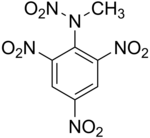Tetryl
 |
|
| Names | |
|---|---|
|
Preferred IUPAC name
N-Methyl-N-(2,4,6-trinitrophenyl)nitramide
|
|
Other names
|
|
| Identifiers | |
|
3D model (Jmol)
|
|
| ChemSpider | |
| ECHA InfoCard | 100.006.848 |
|
PubChem CID
|
|
| UNII | |
| UN number | 0208 |
|
|
|
|
| Properties | |
| C7H5N5O8 | |
| Molar mass | 287.14 g·mol−1 |
| Appearance | Yellow crystalline solid |
| Odor | Odorless |
| Density | 1.73 g/cm3 |
| Melting point | 129.5 °C (265.1 °F; 402.6 K) |
| Boiling point | Decomposes at 187 °C |
| Virtually insoluble | |
| Vapor pressure | <1 mmHg (20°C) |
| Explosive data | |
| Shock sensitivity | Sensitive |
| Friction sensitivity | Sensitive |
| Detonation velocity | 7,570 m/s (24,836 f/s) |
| RE factor | 1.25 |
| Hazards | |
| Lethal dose or concentration (LD, LC): | |
|
LDLo (lowest published)
|
5000 mg/kg (dog, subcutaneous) |
| US health exposure limits (NIOSH): | |
|
PEL (Permissible)
|
TWA 1.5 mg/m3 [skin] |
|
REL (Recommended)
|
TWA 1.5 mg/m3 [skin] |
|
IDLH (Immediate danger)
|
750 mg/m3 |
|
Except where otherwise noted, data are given for materials in their standard state (at 25 °C [77 °F], 100 kPa).
|
|
|
|
|
| Infobox references | |
2,4,6-Trinitrophenylmethylnitramine commonly referred to as tetryl (C7H5N5O8) is an explosive compound used to make detonators and explosive booster charges.
Tetryl is a nitramine booster explosive, though its use has been largely superseded by RDX. Tetryl is a sensitive secondary high explosive used as a booster, a small charge placed next to the detonator in order to propagate detonation into the main explosive charge.
Tetryl is a yellow crystalline solid powder material, practically insoluble in water but soluble in acetone, benzene and other solvents. When tetryl is heated, it first melts, then decomposes and explodes. It burns readily and is more easily detonated than ammonium picrate or TNT, being about as sensitive as picric acid. It is detonated by friction, shock, or spark. It remains stable at all temperatures which may be encountered in storage. It is generally used in the form of pressed pellets, and has been approved as the standard bursting charge for small-caliber projectiles, since it gives much better fragmentation than TNT. It also has greater brisance than any other military high explosive and has an explosive velocity of 23,600–23,900 feet per second (7200–7300 m/s). Tetryl is the basis for the service tetryl blasting caps necessary for positive detonation of TNT. A mixture of mercury fulminate and potassium chlorate is included in the cap to ensure detonation of tetryl.
The most toxic ordnance compounds, tetryl and 1,3,5-TNB, are also the most degradable. Therefore, these chemicals are expected to be short-lived in nature, and environmental impacts would not be expected in areas that are not currently subject to chronic inputs of these chemicals. Tetryl decomposes rapidly in methanol/water solutions, as well as with heat. All aqueous samples expected to contain tetryl should be diluted with acetonitrile prior to filtration and acidified to pH < 3. All samples expected to contain tetryl should not be exposed to temperatures above room temperature. In addition, degradation products of tetryl appear as a shoulder on the 2,4,6-TNT peak. Peak heights rather than peak areas should be used when tetryl is present in concentrations that are significant relative to the concentration of 2,4,6-TNT.
...
Wikipedia
